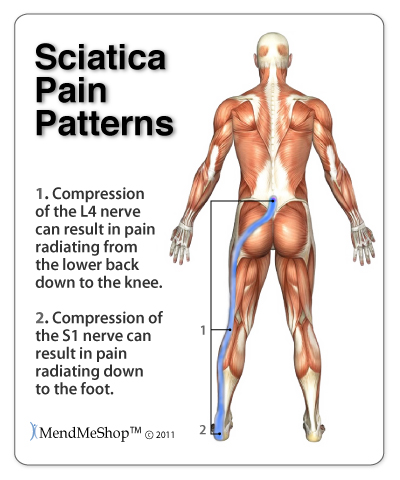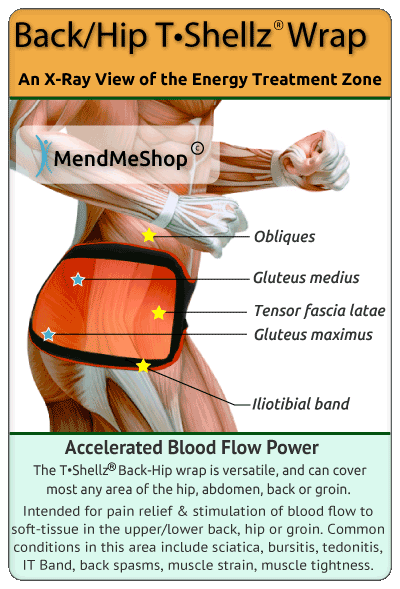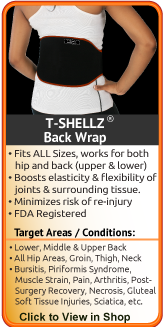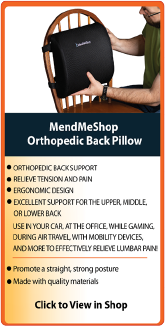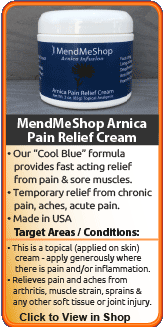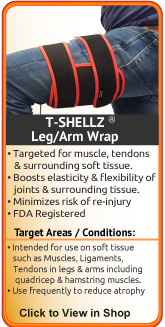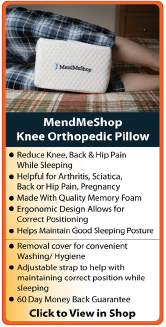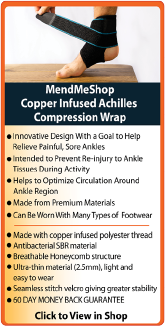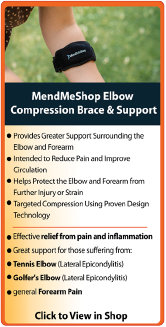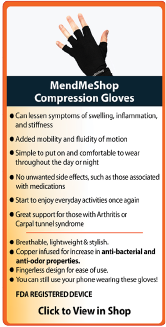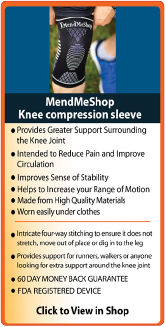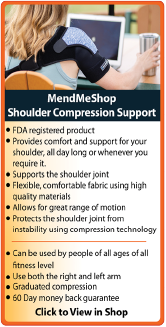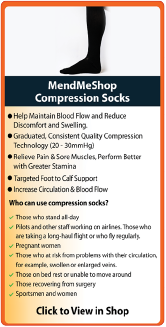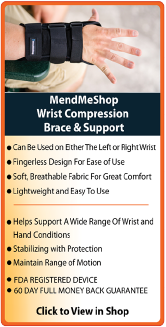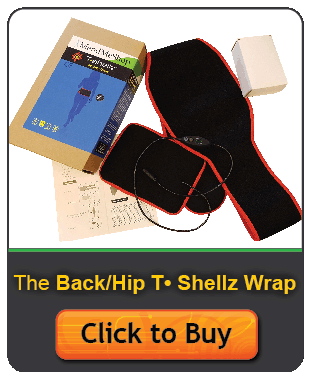Treating Sciatica Pain
Sciatica, also called sciatic neuritis, is used to describe symptoms of pain, tingling, numbness and weakness that can radiate from the lower back all the way down to the foot.
These symptoms result from the compression or irritation of one of 5 nerve roots in the spine (sacral nerves S1, S2, or S3 or lumbar nerves L4 or L5) that connect and form the 2 sciatic nerves, or pinching or irritation of the sciatic nerve itself.
The sciatic nerve is the longest and thickest nerve in the body, and originates in the lumbar spine. It then runs down through the buttock area and continues along the back of the leg and branches off to the tibial and common fibular (peroneal) nerves down to the foot.
In most cases, when a sciatic nerve is compressed only one side is affected with pain, although the pain may alternate from one side to the other. Occasionally, the pain is felt on both sides of the lower back and legs.
Although sciatica pain can be debilitating, most people who suffer from sciatica can find pain relief with non-surgical treatments such as cold compression, ultrasound therapy and other standard conservative treatment options. It is a condition that usually gets better with time and rest. Treating the cause of the nerve compression is important to prevent sciatica pain from returning.
Causes of Sciatica
Sciatica symptoms are caused by the sciatica nerve being compressed. This compression can occur for a number of reasons in various locations and treatment will depend on the cause. Common reasons for compression of the sciatic nerve are:
- A herniated or slipped disc in the lumbar or sacral spine
- Strain, inflammation, and swelling of the piriformis muscle (piriformis syndrome)
- Pregnancy
- Poor posture
- Short leg syndrome
- Wearing high heels
- Overcompensating for other injuries in the knee (ACL injury), lower leg (shin splints), ankle (sprain) or hip (bursitis)
- Damage to the vertebrae in the lumbar or sacral spine
- Disc degeneration in the lumbar or sacral spine
- Tumor in the spine
- A sharp blow or injury to the lower back or buttock area causing injury to the pelvis
- Autoimmune disorders
Symptoms of Sciatica
- Pain, tingling or numbness that radiates through the lower back, buttocks, and down the back of the leg possibly as far as the foot
- Pain starts slowly and worsens after standing, sitting, bending backward, walking or sleeping at night
- Difficulty walking, bending and or sitting
- Muscle weakness in the hip and/or leg
Treatment
Compression of the sciatic nerve can occur in various locations and the exact cause and location is not always known. Treating the symptoms can be helpful to manage the pain but treating the source of the compression will result in faster sciatica relief. We recommend that you see your doctor for a proper diagnosis and to determine the cause of the compression on the sciatic nerve.
TShellz Wrap® for the Lower Back and Hip
The Back/Hip TShellz Wrap® should be used over your lumbar region and lower back to improve blood flow in the area. Your body depends on a fresh supply of blood to improve the health of soft tissue and deal with inflammation to relieve the compression of your sciatic nerve.
Unfortunately, when you are suffering from sciatica it can be painful to even walk or lift your leg. When you limit movement in your hip the blood flow is reduced, starving your tissue of the necessary oxygen and nutrients.
The trick is to find a way to increase blood flow without causing pain and/or further straining the muscle or discs. This is where the enhanced blood flow due to the TShellz Wrap® comes in, as enhanced blood flow compliments your body's natural healing process.
The energy emitted from the Energy Pad - the emitter component of the Back/Hip TShellz Wrap® stimulates blood flow in the treatment area - specifically the lower back and hip - more than your body would ever be able to generate on it's own, giving your body the boost it needs to keep your spine and lower back muscles as healthy as possible and reduce the risk of irritation, inflammation and herniation.
Cold & Compression for Inflammation Induced Sciatica
If you are experiencing referred pain above the knee or in your lower leg caused by the compression of your sciatic nerve, a cold compress can be quite helpful in cases where nerve pressure is caused by inflammation. The cooling sensation along with the compression can help to numb the nerves to help alleviate the pain. However, it is important to treat it at the point where pressure is being put on the nerve, which is not necessarily the same place as where the pain is noticed. The term for an injury indicating pain elsewhere in the body is termed as "referred pain", and is somewhat common when dealing with nerve-based pain.
A Note On OverCompensation
Since you are reading this, you probably know that sciatica will alter your body mechanics. Adjustments to your gait from sciatica can wreak havoc on your knees, hips and lower back due to overcompensation. Recovery takes a longer time for such chronic (long term) injuries, but proper healing is essential to regain strength and get you back to the activities you enjoy.
The longer your injury endures, the greater the risk of running into serious overcompensation injuries and a permanent change in gait.
To Stop Re-Injury & Reduce the Risk of a More Serious Overcompensation Injury, You Need to Heal Quickly & Completely!
Anyone in need of rapid recovery and complete healing must consider a comprehensive treatment plan that includes an effective means to minimize swelling and inflammation yet also stimulate healing and tissue elasticity. We have found no better set of tools that can be used at home than this:
A Conservative Home Treatment Protocol Many Of Our Clients Found To Be Very Beneficial:
- A Cold Compress or Ice Pack to reduce inflammation of the soft tissue injury (as soon as possible).
- A Back-Hip TShellz Wrap to increase blood-flow to the hip, groin and/or lower back, relieve pain and help increase flexibility of soft tissue.
- MendMeShop Arnica Pain Cream for temporary relief of pain due to sore muscles and joints.
- An Exercise & Stretching Plan to prevent muscle atrophy and shortened tendons. A proper plan will increase elasticity and strengthen the muscles of the hip and tendons of the hip.
Conservative treatment tools just like these have been used successfully by thousands of back and hip injury sufferers - just like you.

TShellz Wrap® = Increased Blood Flow in Your Back We believe the use of TShellz Wraps® for effective pain relief and inflammation control of soft tissue injuries is one of the most under-utilized home treatment options available on the market today. We have client after client that have tried many options out there and have been amazed at how effective and fast the TShellz Wrap treatment can relieve pain and increase blood flow in soft tissue.
With regular use of the Back-Hip TShellz Wrap:
- Your pain will be reduced.
- Due to increased blood flow, your body's ability to recover from soft tissue damage will be maximized.
- Your corresponding hip will have a larger range of motion and increased extensibility of collagen tissue. (Chapter 9 of "Therapeutic Heat and Cold", 4th edition.
(amazon.com link - Ed. Justus F. Lehmann, M.D., Williams, and Wilkin)
Doctors and Surgeons are always improving the techniques used in surgery, and results from surgery now are much more positive than they were in the past. However, all surgeries introduce scar tissue, and recovery from hip and back surgery is better than ever but often disappointing when it comes to full recovery expectations.
If you do wind up getting surgery, know that rehabilitation at-home while attending regular physical therapy or doctor appointments is vital for your overall recovery.
Consistent exercise and conservative treatment on a daily basis during your rehabilitation while working with your doctor or physical therapist is key. This is why you should seriously consider maximizing your recovery by using the TShellz Wrap® at home once you are approved for physical therapy.
The more consistent you work at enhancing blood flow to injured soft tissue, the more consistent the healing process will be. Nourishing soft tissue with greater levels of oxygen and nutrients (which are carried through the blood stream) will give the body a better ability to produce new, healthy collagen. In effect, you will help the body produce stronger tissues while potentially reducing the number of setbacks that can occur following surgical procedures.
Click HERE to Go To Our Online Store We take all major credit cards and Paypal.
If you have questions, call our office at 1-866-237-9608 (toll free continental US).
We are currently offering FREE SHIPPING and a 60 day trial period on all our Wraps.
A TShellz Wrap® application is intended to produce the following results:
Enhance blood circulation and
increase the levels of oxygen within your blood.
This, in turn, improves function of the immune system which increases the body's ability to eliminate toxins and other waste by-products resulting from damaged tissue within the back. This allows the back to more easily stimulate the self healing process.
Stimulates the production of collagen,
which is a building block for human tissue.
Many back injuries are the result of trauma to a tendon or muscle, usually causing the tissue to tear. As a result of the tear, your body triggers a natural healing process resulting in pain, inflammation, and the creation of scar tissue, then eventually reinforcing that band-aid solution with flexible tissue (proliferation). Increased blood flow will make this process more quick and efficient in the majority of cases.
It is generally accepted that heat will enhance both the flexibility and the extensibility of soft tissue.
This is an important point. Many people with back conditions often re-injure their back due to the fact the damaged muscle or soft tissue is tight and the range of motion of the back is restricted. Even the most minor of activities can cause a recovering back to strain, sprain, or even tear. Every time this happens, your recovery is delayed. This is why using the TShellz Wrap® not only now, but also into the future, is wise. The TShellz Wrap® warms tissue, and thereby increases it's elasticity...all without risk of causing further harm and greatly reducing your chances of re-injury.
It is also intended to provide relief to some who are dealing with nerve related issues.
TShellz Wraps® applied to muscles and soft tissue that surround the nerves should help them become more loose, as heat is known to increase the flexibility and extensibility of soft tissue. You may find this will alleviate tightness which may have led to nerve compression and the subsequent pain it produces.
Intended to reduce stiffness in joints.
Osteoarthritis in the back occurs when cartilage and meniscii degenerate. Over time, the base of the femur (upper leg bone) rubs against the tibia (lower leg bone) with little or no protection from the cartilage. This leads to pain in the back joint. The space within the joint starts to decrease without the cushioning and stiffness in the back becomes a problem. The TShellz Wrap® is intended to generate warmth and an increase in blood flow - resulting in less stiffness and better range-of-motion.
Contributes to your overall well-being.
Increased blood flow should result in a stronger immune system and an ability for your body to recover from soft tissue injuries more quickly.
Believe me when I say this; words alone cannot accurately describe what the TShellz Wrap® can do for you. It truly is something you need to experience first-hand.
What Else Makes the TShellz Wrap® So Special?
The TShellz Wrap® will stimulate blood flow in the local area, while also warming up the tissue. It is known that warmed tissue will experience a larger range of motion and increased extensibility and this is exactly what you want when you are trying to recover from a soft tissue injury. Increased extensibility and flexibilty in soft tissue means it is less likely to strain or tear further during activity, and less re-injury during this period means less setbacks during healing. Less re-injury helps minimize the build up of scar tissue around the tendon during the healing process, while also reducing the risk and severity of overcompensation pain and secondary injuries. Basically, the value of a faster recovery is often underestimated, as the impact of chronic injuries can quickly spiral out of control.
We can promise that you will receive a product that is designed to be safe and does what it is supposed to do...quickly relieve pain and aid in the recovery from tendon, muscle and other soft tissue injuries.
The unit plugs into a standard wall outlet to get its power. The nice thing about the power supply is that the same unit can be used in North America and overseas as well. It has the capability to operate between 110v and 230v. It has a special controller that can be set for 3 different power levels of application (3=High, 2=Medium, 1=Low). The cord is long so you can sit or lie comfortably and watch TV, read or surf the net while you're using it.
The safety time on the wrap is 30 minutes though our recommended treatment time is 10 minutes in duration on the low setting. The device can be worn over clothing, allowing you to use the device at work, at home, or really anywhere you have access to an electrical outlet.
Conservative Treatment Tools Our Clients Have Used to Help Limit Lower Back & Hip Damage & Boost The Body's Soft Tissue Repair Process at Home:
- A Cold Compress or Ice Pack to reduce inflammation wherever there is pain and/or swelling (as soon as possible).
- An Back TShellz Wrap to increase blood-flow to the back and hip area (a Localized Enhanced Circulatory Response® Treatment).
- MendMeShop Arnica Pain Cream for temporary relief of pain due to sore muscles and joints.
- A High Quality Back Pillow if you are experiencing discomfort when resting or or sitting.
- A high quality, adjustable LOWER BACK BRACE for core support and risk reduction of further injury.
- An Exercise & Stretching Plan to increase/retain elasticity and strengthen the muscles and tendons in the back and hip.
Conservative treatment tools just like these have been used successfully by thousands of soft tissue injury sufferers - just like you.

TShellz Wrap® = Enhanced Blood Flow in the Treatment Area
We believe the use of TShellz Wraps® for boosting blood flow to soft tissue in the area of application is one of the most under-utilized home treatment options available on the market today. We have client after client that have tried many options out there and have been amazed at how effective and fast the TShellz Wrap treatment can relieve pain and increase blood flow in the treatment area.
With regular use of the TShellz Wrap:
- Your pain will be reduced*.
- Due to increased blood flow, soft tissue in the treatment area will be expected to recover at an accelerated rate with reduced potential for re-injury*.
- Tissue in the treated area should experience a larger range of motion and increased extensibility of collagen tissue* due to the heat effect on soft tissue. This should translate into a reduced rate of re-injury occurrence as soft tissue is known to lengthen and become more flexible when exposed to warm temperature. (*Chapter 9 of "Therapeutic Heat and Cold", 4th edition.
(amazon.com link - Ed. Justus F. Lehmann, M.D., Williams, and Wilkin)

Product Advisors are available 9:00 am to 5:00 pm Eastern Standard Time Monday to Friday.
Learn More About Hip Joint Injuries & TreatmentsI want to learn more about Hip Surgery & Post-Surgery Recovery I want to learn more about Circulation Boost I want to learn more about Ice & Heat: Which Is Better For The Hip? I want to learn more about Trigger Points in the Hip I want to learn more about Hip Surgery: Do I Need It?
FREE SHIPPING ON ALL OUR PRODUCTS
During your recovery, you will probably have to modify and/or eliminate any activities that cause pain or discomfort at the location of your soft tissue injury until the pain and inflammation settle. Always consult your doctor and/or Physical Therapist before using any of our outstanding products, to make sure they are right for you and your condition. The more diligent you are with your treatment and rehabilitation, the faster you will see successful results!
| 